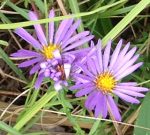 Native to North Carolina and Virginia this herbaceous perennial grows in dry woodlands, forest edges, and abandoned fields as well as was areas such as roadsides. It is a member of the aster family, Asteraceae, that also includes daisy, sunflower, and lettuce. Growing from a rhizomatous root system, plants have one to several erect stems that are 1-3′ tall and covered with soft hairs. The linear to lanceolate leaves that are stiff, rough, and up to 3″ long. In fall 1.25-1.5″ wide flowerheads appear at the tips of leafy bracts. Each flower has 20-30 red to purple ray flowers surrounding yellow disc flowers. The genus name, Sumphyotrichum, comes from the Greek words symph meaning coming together and trich meaning hair and may refer to the anthers of the flowers. The specific epithet, grandiflorus, comes from the Latin words grandis meaning large and flos meaning flowers and refers to the relatively large size of the flowerheads. The genus name aster comes from the Greek/Latin word aster meaning star and refers to the appearance of the flower heads.
Native to North Carolina and Virginia this herbaceous perennial grows in dry woodlands, forest edges, and abandoned fields as well as was areas such as roadsides. It is a member of the aster family, Asteraceae, that also includes daisy, sunflower, and lettuce. Growing from a rhizomatous root system, plants have one to several erect stems that are 1-3′ tall and covered with soft hairs. The linear to lanceolate leaves that are stiff, rough, and up to 3″ long. In fall 1.25-1.5″ wide flowerheads appear at the tips of leafy bracts. Each flower has 20-30 red to purple ray flowers surrounding yellow disc flowers. The genus name, Sumphyotrichum, comes from the Greek words symph meaning coming together and trich meaning hair and may refer to the anthers of the flowers. The specific epithet, grandiflorus, comes from the Latin words grandis meaning large and flos meaning flowers and refers to the relatively large size of the flowerheads. The genus name aster comes from the Greek/Latin word aster meaning star and refers to the appearance of the flower heads.
Type: Herbaceous perennial
Bloom: Autumn flowerheads with red t purple ray flowers surrounding yellow disc flowers
Size: 1-3′ H x 12-24″ W
Light: Full sun to partial shade
Soil: Average, dry to medium moist, well-drained
Hardiness: Zones 3-9
Care: Pinch early in season to encourage bushiness
Pests and Diseases: None of significance
Propagation: Division, seed
Companion Plants: Goldenrod, Joe Pye weed, Sedum ‘Autumn Joy’, chrysanthemums
Photo Credit: Geekgecko Wikipedia